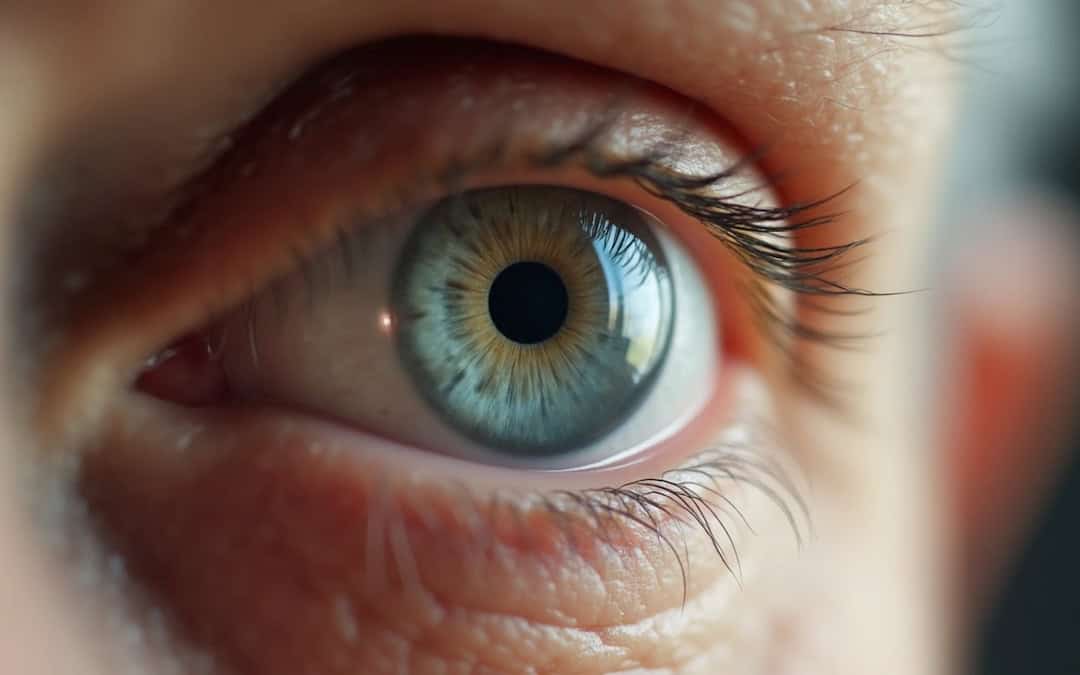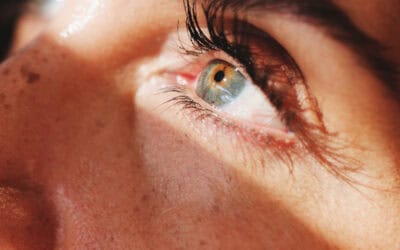Cataracts are a leading cause of blindness as you grow older. Your risk increases dramatically with age: nearly 1 in 5 Americans over 65 have vision-affecting cataracts, and more than half of Americans over 80 years old either have a cataract or have had cataract surgery.
Cataracts develop slowly without warning signs, quietly clouding your eye lens while you go about your daily life. Vision loss happens so gradually that you won’t notice changes until significant damage has already occurred.
The protein breakdown in your lens that is associated with cataract development actually begins around age 40, though you might not experience symptoms like clouded vision, night vision problems, or light sensitivity until years later. This delayed onset explains why so many people miss the early warning signs until cataracts seriously impact their quality of life.
Whether you’ve noticed recent vision changes or simply want to protect your eye health for years to come, understanding what really causes cataracts could save your sight. Age plays the primary role, but environmental triggers like UV exposure and smoking, along with medical conditions such as diabetes, all contribute to cataract development.
This article reveals the three main types of cataracts, their hidden causes, and the subtle symptoms you might overlook before vision problems become obvious.
What are Cataracts and How do they Affect Vision?
A cataract forms when the normally clear lens in your eye becomes cloudy. This happens because proteins in the lens break down and clump together, blocking light from reaching your retina properly. Similar to a camera lens, when your eye lens becomes foggy the entire image becomes distorted.
What do cataracts look like?
From the outside, a severe cataract might appear as visible clouding in your pupil area. Inside your eye, the lens develops a foggy or milky appearance that completely changes how you see the world.
Your vision transforms dramatically when cataracts develop. Imagine looking through a frosty window or trying to see through a dusty car windshield. Colors lose their richness, appearing faded or yellowish. Everything seems less vibrant than it once was.
The clouding starts small and spreads gradually across more of your lens. You might not notice any vision changes initially, but as the cataract grows, your sight becomes increasingly hazy and blurred.
Many people describe the visual experience as if they are looking through wax paper. When you have cataracts, objects lose their sharp edges and clear definition.
How cataracts change your daily life
Cataracts disrupt your everyday activities in ways that sneak up on you. Reading becomes a struggle as text appears blurry, particularly when lighting isn’t ideal. You might find yourself constantly cleaning your glasses, assuming they’re dirty, when the real problem lies inside your eye.
Driving presents serious challenges, especially at night when headlights create uncomfortable glare or halos. The increased light sensitivity makes sunny days feel overwhelming rather than pleasant.
Your social connections may also suffer. Recognizing faces from across a room becomes difficult, and dimly lit restaurants turn into visual obstacles. Simple pleasures like cooking, gardening, or pursuing hobbies such as painting become sources of frustration rather than enjoyment.
The loss of independence hits hardest. Tasks you once performed effortlessly now require brighter lighting, magnifying glasses, or assistance from others. While cataracts develop slowly, they eventually interfere with your quality of life enough to demand treatment.
What Really Causes Cataracts
Age gets blamed for most vision problems, but the real story behind cataracts involves multiple factors working together. Understanding these root causes helps you recognize your personal risk factors and take steps to protect your sight.
Age-related protein breakdown
Your lens contains specialized proteins that maintain perfect clarity for decades. As you age, these proteins gradually break down and clump together, creating the cloudiness that defines cataracts.
This process starts surprisingly early—significant changes often occur in the first 10-15 years of life, though visible symptoms don’t appear until decades later. The proteins undergo complex chemical modifications including racemization, deamidation, truncation, and crosslinking. Unfortunately, once the proteins clump together, they can’t return to their original clear state.
Protein breakdown accelerates after age 40, when protective mechanisms that previously maintained lens clarity become less effective. This explains why most people notice their first cataract symptoms in their 50s or 60s, even though the underlying damage started much earlier in their lives.
Diabetes and blood sugar damage
Diabetic patients are up to five times more likely to develop cataracts at an earlier age.
The connection between diabetes and cataracts run deeper than most people realize. Elevated blood glucose levels damage the tiny blood vessels in your eye and cause swelling in the fluid between your eyeball and cornea. When glucose levels remain high, enzymes in your lens convert glucose to sorbitol, causing the lens to swell and your vision to blur.
The longer you’ve had diabetes, the greater your risk becomes. Studies show over 8% of type 1 and almost 25% of type 2 diabetics need cataract surgery within a 10-year period.
Environmental triggers that damage your lens
There are also environmental and lifestyle factors that can contribute to cataract development. Among these are exposure to Ultraviolet (UV) rays, smoking and alcohol consumption.
UV radiation significantly contributes to cataract formation. UV light damages lens proteins through a process called glycation, even without oxygen present. Since regular sun exposure can increase your cataract risk it is always important to wear appropriate sunglasses to help protect your eyes.
Smoking creates oxidative stress in your lens by generating free radicals and reducing antioxidant levels. Current smokers who consume more than 15 cigarettes daily have a 42% higher risk of cataract extraction compared to non-smokers.
Moderate alcohol consumption may actually reduce cortical cataract risk, though heavy drinking combined with smoking increases nuclear cataract prevalence.
Medications that cloud your vision
Over 70 drugs have been linked to increased cataract risk. Corticosteroids represent the biggest concern as these medications affect your lens through different mechanisms than natural aging.
Other potentially problematic medications include certain psychotropic drugs, statins, and chemotherapy agents. Your risk typically depends on both dosage and duration of use.
The eye doctors at Chang Eye Group will review your current medications and health history to help you maintain your vision and manage any signs of cataracts or other conditions. Schedule an appointment at one of our convenient locations in Pittsburgh.
Your genetic blueprint
Your genetic makeup plays a significant role in cataract development. Studies indicate genetics account for 35-48% of nuclear cataract risk and 53-75% of nuclear and cortical cataract combined.
Babies born with cataracts are likely due to faulty genes being passed from parents to children. In fact, about 20% of congenital cataract cases have a family history.
Furthermore, researchers have identified 115 genes and 38 disease-causing genes associated with cataract formation. And cataracts can also accompany chromosome abnormalities like Down syndrome.
Hidden Signs of Cataracts You Might Miss
Early cataracts often work like quiet intruders, revealing themselves through changes you might easily dismiss as normal aging. Recognizing these warning signs early can make the difference between preserving your vision or facing more serious sight loss later.
Subtle color fading
Colors around you can gradually lose their brilliance without you realizing that it’s happening. Instead of the bright, vivid world you once saw, everything appears increasingly dull or muted.
As cataracts progress, your lens proteins clump together and may become yellow or brown in color, casting a warm tint over your entire visual field. This can make it particularly difficult to distinguish blue and purple colors from one another.
This color desaturation happens so slowly that your brain compensates, making the change nearly impossible to detect until it becomes quite advanced. You might not notice that the deep blue sky looks grayish or that purple flowers appear more brownish than before.
Increased light sensitivity
Bright environments that never bothered you before may suddenly feel overwhelming. The clouded lens scatters incoming light rather than focusing it precisely on your retina. This light scattering creates uncomfortable intensity that forces you to squint or cover your eyes in situations you once handled easily.
Sunny days become harsh and unwelcome. Indoor lighting feels too bright. Even reflected light from snow or water can cause significant discomfort. This photophobia often disrupts your daily activities long before you notice other vision changes.
Frequent changes in glasses prescription
Another potential indicator of cataract development is if you need stronger glasses every few months despite having no history of rapid vision changes. This may be happening because cataracts, not refractive errors, are causing your vision problems.
The changing density of your lens directly affects how light focuses on your retina. You might leave the eye doctor’s office feeling frustrated that your “new” glasses don’t seem much better than your old ones. Be sure to discuss this with your eye doctor as it is a classic sign that something beyond prescription changes is affecting your sight.
Seeing halos or glare at night
When cataracts develop in your eyes, nighttime driving can become increasingly hazardous as light scattering creates noticeable halos or rings around oncoming headlights and streetlights. This diffraction effect makes it dangerous to drive after dark, often before your daytime vision shows obvious problems.
What once was a simple evening drive to the store becomes an anxiety-inducing experience. The halos and glare can be so severe that many people with developing cataracts stop driving at night entirely.
Double vision in one eye
Unlike other causes of double vision, cataract-related diplopia typically affects just one eye.
Try this simple test: close one eye and if you still see double, cataracts might be developing.
This type of double vision occurs because the irregular lens surface splits light rays before they reach your retina. If you notice this symptom, schedule an appointment with an eye doctor in Pittsburgh at Chang Eye Group for proper diagnosis and treatment options.
What are the 3 types of cataracts?
Understanding which type of cataract you might be developing helps you recognize symptoms and understand what to expect. Eye doctors classify cataracts based on where cloudiness forms in your lens, with each type creating distinct symptoms and progression patterns.
Nuclear cataracts
Nuclear cataracts develop in the center of your lens and represent the most common form. About 40% of people over 75 years old have nuclear cataracts in at least one eye. These cataracts begin as nuclear sclerosis, a normal hardening and yellowing of the eye lens that occurs with age.
As proteins in your central lens break down and clump together, your lens gradually turns yellow or brown. This color change makes distinguishing between blues and purples increasingly difficult. You might initially experience what doctors call “second sight”, which actually improves near vision for a short time, but this disappears as the cataract progresses.
Nuclear cataracts typically develop slowly over many years, causing blurry vision, difficulty seeing in dim light, and increased sensitivity to glare.
Cortical cataracts
Cortical cataracts attack the outer edges of your lens, creating distinctive white, wedge-shaped opacities that start at the periphery and gradually extend toward the center. Think of these “spokes” as barriers that scatter light entering your eye, causing significant glare and light sensitivity before your central vision becomes severely affected.
Your risk increases substantially if you have diabetes or high blood pressure. Symptoms include decreased color perception, problems with depth perception, and difficulty seeing contrast in low light conditions.
Unlike nuclear cataracts, cortical cataracts often develop relatively quickly, sometimes progressing over just a few months.
Posterior subcapsular cataracts
Posterior subcapsular cataracts (PSC) form at the back of your lens, directly in the path of incoming light. Though less common, PSC makes up only about 3% of cataracts in one eye. However, these cataracts cause more severe symptoms faster than other types. PSCs can progress to vision loss in weeks or even days rather than months or years.
Risk factors include steroid medication use, diabetes, eye injuries, and radiation exposure. These cataracts primarily affect near vision, causing pronounced difficulty reading, significant glare in bright light, and halos around lights.
If you notice these symptoms developing rapidly, schedule an appointment with an eye doctor in Pittsburgh at Chang Eye Group for immediate evaluation. PSCs typically require more urgent treatment than other cataract types.
Vision-Saving Knowledge You Can Act On Today
Cataracts represent one of the most common vision challenges you’ll face as you age. Understanding the causes, from natural protein breakdown to environmental triggers like UV exposure and smoking, will help you recognize your personal risk factors and take preventive action.
The hidden warning signs we’ve explored, from subtle color fading to increased light sensitivity and night halos, often appear years before obvious vision problems develop. Catching these early symptoms can make the difference between preserving your sight and losing it permanently.
Whether you’re dealing with nuclear cataracts in the lens center, cortical cataracts at the edges, or posterior subcapsular cataracts at the back, all three types eventually interfere with your daily activities and independence. This makes regular eye examinations essential, particularly after age 40 when protein changes accelerate in our eyes.
Modern cataract surgery is one of the safest and most effective medical procedures.
Early detection of developing cataracts offers the best chance for preserving your vision and maintaining your lifestyle.
Your eyesight is too valuable to compromise. The subtle warning signs you watch for today could safeguard your vision for decades to come. If you notice any vision changes or suspect developing cataracts, schedule an appointment with an eye doctor in Pittsburgh at Chang Eye Group for proper diagnosis and treatment options.
FAQs
Q: What are the early signs of cataracts that people often overlook?
A: Early signs include subtle color fading, increased sensitivity to light, frequent changes in eyeglass prescriptions, seeing halos around lights at night, and experiencing double vision in one eye. These symptoms often develop gradually and may be easily dismissed.
Q: How do cataracts affect daily life?
A: Cataracts can make reading challenging, cause difficulty driving at night due to glare, increase light sensitivity, and make it harder to recognize faces or perform detailed tasks. Over time, cataracts can significantly impact independence and quality of life.
Q: Are there different types of cataracts?
A: Yes, there are three main types of cataracts: nuclear cataracts forming in the center of the lens, cortical cataracts affecting the outer edges, and posterior subcapsular cataracts developing at the back of the lens. Each type has distinct characteristics and progression patterns.
Q: Can certain medical conditions increase the risk of developing cataracts?
A: Yes, medical conditions like diabetes can significantly increase the risk of cataract development. Diabetic patients are up to five times more likely to develop cataracts at an earlier age compared to non-diabetics.
Q: Is it possible to prevent or slow down cataract formation?
A: While not entirely preventable, you can potentially slow cataract formation by protecting your eyes from UV radiation, avoiding smoking, moderating alcohol consumption, and managing conditions like diabetes. Regular eye check-ups are crucial for early detection and management.






